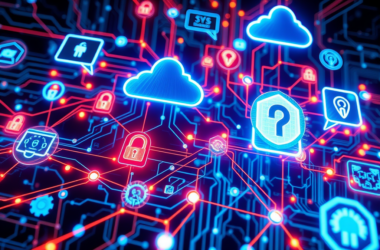The digital transformation of the energy sector, while bringing significant efficiencies and advancements, has also dramatically expanded the attack surface for malicious actors. As we approach 2025, the convergence of geopolitical tensions, technological advancements in cyber weaponry, and the increasing interconnectedness of operational technology (OT) and information technology (IT) systems within energy utilities creates a perfect storm, positioning this year as a potential tipping point for cyberattacks on critical infrastructure. This introduction explores the factors contributing to this heightened risk and sets the stage for a discussion on proactive cybersecurity strategies.
The Looming Shadow of 2025 – A Tipping Point for Energy Infrastructure Cyberattacks
The traditional view of cybersecurity in the energy sector has often focused on perimeter defense and reactive incident response. However, the threat landscape is evolving at an unprecedented pace, demanding a paradigm shift towards proactive security measures. We are moving beyond the era of isolated attacks targeting specific systems to an era of coordinated, multi-vector campaigns designed to cripple entire energy grids. This shift is driven by several converging factors:
- The rise of “hybrid warfare” tactics: Nation-state actors are increasingly employing cyberattacks as a tool of hybrid warfare, seeking to disrupt critical infrastructure and destabilize economies without resorting to conventional military force. Energy utilities, as essential components of national infrastructure, are prime targets for these attacks. This is not merely about data exfiltration or financial gain; it’s about exerting political influence and causing widespread disruption. We are seeing a blurring of lines between cybercrime and state-sponsored attacks, making attribution and response even more complex.
- The increasing sophistication of malware: Advanced persistent threats (APTs) are becoming increasingly sophisticated, utilizing AI-powered malware that can evade traditional detection methods and adapt to defensive measures in real-time. These attacks are not just about exploiting known vulnerabilities; they are about discovering and exploiting zero-day vulnerabilities, often remaining undetected for extended periods while silently compromising critical systems. This requires a shift from signature-based detection to behavioral analysis and threat hunting.
- The “democratization” of cyber weapons: Cyberattack tools and techniques are becoming increasingly accessible, lowering the barrier to entry for less sophisticated actors. This “democratization” of cyber weapons means that even smaller groups or individual hackers can now launch attacks that were once the exclusive domain of nation-states. This proliferation of offensive capabilities significantly expands the pool of potential attackers and increases the frequency and diversity of attacks.
For CISOs, CFOs, and information security leaders in the energy sector, these trends represent a significant challenge. The potential consequences of a successful attack are no longer limited to financial losses or reputational damage; they now include the disruption of essential services, cascading infrastructure failures, and even potential environmental disasters. This necessitates a proactive and multi-layered approach to cybersecurity, one that goes beyond traditional security measures and embraces a culture of continuous monitoring, threat intelligence, and proactive defense. This paper will outline the key elements of such an approach and provide actionable strategies for mitigating the escalating risks facing the energy sector in 2025 and beyond.
The Evolving Threat Landscape: Understanding the Impending Storm
The cybersecurity landscape is constantly shifting, with new threats emerging and existing threats evolving in sophistication. For the energy sector, understanding these evolving threats is crucial for developing effective defense strategies. This section delves into the key trends shaping the threat landscape, providing a deeper understanding of the challenges facing energy utilities in 2025 and beyond.
The Rise of Nation-State Actors and Advanced Persistent Threats (APTs): Nation-state actors view energy infrastructure as a strategic target for espionage, disruption, and even sabotage. Their APT campaigns are characterized by meticulous planning, advanced malware, and a focus on long-term infiltration. What sets these actors apart is their access to significant resources, including zero-day exploits and sophisticated social engineering tactics. They often employ “living off the land” techniques, using existing system tools to blend in with normal network activity, making detection incredibly difficult. Moreover, these actors are increasingly leveraging supply chain compromises to gain access to target networks, effectively bypassing traditional perimeter defenses. This focus on long-term access and covert operations requires a shift from reactive incident response to proactive threat hunting and continuous monitoring.
The Convergence of IT and OT: Expanding the Attack Surface: The increasing integration of IT and OT systems, while offering significant operational efficiencies, has also created a larger and more complex attack surface. Traditionally isolated OT networks are now connected to IT networks, exposing them to a wider range of cyber threats. This convergence also introduces new challenges in terms of security management, as IT and OT systems often have different security protocols and requirements. A critical, often overlooked, aspect of this convergence is the increased reliance on cloud-based solutions for OT management and data analytics. While cloud services offer scalability and cost-effectiveness, they also introduce new security considerations related to data ownership, access control, and regulatory compliance.
The Weaponization of AI and Machine Learning: A New Era of Cyber Offense: Cybercriminals are increasingly leveraging AI and machine learning to automate attacks, evade detection, and develop more sophisticated malware. AI-powered malware can learn from its environment, adapt to defensive measures in real-time, and even autonomously discover new vulnerabilities. This represents a significant escalation in the cyber arms race, requiring a corresponding investment in AI-driven cybersecurity solutions. A less discussed aspect of this weaponization is the use of AI for deepfake generation to conduct highly targeted phishing attacks against key personnel within energy utilities. These deepfakes can convincingly impersonate executives or trusted partners, making it much harder for employees to detect malicious communications.
The Exploitation of Supply Chain Vulnerabilities: Weak Links in the Chain: The complex supply chains of energy utilities represent a significant vulnerability. Attackers are increasingly targeting third-party vendors and suppliers to gain access to critical infrastructure. These attacks can be highly effective because smaller suppliers often have less robust security measures in place. A key factor to consider is the increasing reliance on open-source software within the energy sector’s supply chain. While open-source software offers many benefits, it also introduces potential vulnerabilities that can be exploited by attackers. A comprehensive supply chain risk management strategy is essential, including thorough security assessments of all vendors and suppliers, as well as ongoing monitoring for potential threats. This must go beyond simple compliance checks and delve into the actual security posture and practices of each vendor.
The Devastating Consequences of a Successful Attack: Beyond Financial Losses
The consequences of a successful cyberattack on energy infrastructure extend far beyond immediate financial losses. These attacks can have cascading effects, impacting essential services, the environment, and public trust. This section explores the wide-ranging and often underestimated consequences of such attacks, highlighting the critical need for proactive cybersecurity measures.
Disruption of Essential Services: Cascading Failures and Societal Impact: A successful cyberattack on an energy utility can trigger widespread power outages, gas shortages, and disruptions to other essential services that rely on energy, such as water treatment, transportation, and communication networks. These disruptions can have a significant societal impact, affecting businesses, hospitals, and emergency services. A seldom-discussed consequence is the psychological impact on the population. Prolonged outages can lead to anxiety, fear, and a loss of confidence in public institutions. Furthermore, the reliance on just-in-time delivery systems for many essential goods means that even short-term disruptions can lead to supply chain bottlenecks and shortages of critical supplies.
Financial Implications: Direct Costs and Long-Term Damage: The financial implications of a cyberattack are substantial, encompassing direct costs such as incident response, system recovery, legal fees, regulatory fines, and potential ransom payments. However, the long-term financial damage can be even more significant, including loss of revenue, damage to brand reputation, decreased customer trust, and a decline in stock value. A frequently overlooked financial consequence is the cost of increased insurance premiums following an incident. Cyber insurance providers are becoming increasingly selective and are demanding more robust security measures from their clients. A successful attack can significantly increase premiums or even make it difficult to obtain coverage.
Environmental Damage: The Unseen Impact of Cyberattacks: Cyberattacks can trigger environmental disasters by disrupting control systems that manage critical processes, such as oil and gas pipelines, power plants, and water treatment facilities. These disruptions can lead to oil spills, gas leaks, chemical releases, and other environmental hazards. The long-term environmental remediation costs can be enormous, and the damage to ecosystems can be irreversible. A less considered aspect is the potential for cyberattacks to exacerbate existing environmental challenges, such as climate change. For example, an attack on a renewable energy grid could disrupt the supply of clean energy, hindering efforts to reduce carbon emissions.
Loss of Public Trust and Confidence: Eroding the Foundation of Energy Security: A successful cyberattack on an energy utility can severely erode public trust and confidence in the energy sector. This loss of trust can have lasting impacts on customer relationships and the overall stability of the energy market. Consumers may switch to alternative providers, investors may become hesitant to invest in the sector, and regulators may impose stricter regulations. A critical, yet often overlooked, consequence is the potential for social unrest and civil disorder following a major disruption of essential services. When people lose faith in the ability of critical infrastructure to function reliably, it can lead to widespread anxiety and even social unrest. This highlights the importance of not only preventing attacks but also effectively communicating with the public during and after an incident to maintain trust and confidence.
The Proactive Defense: A Multi-Layered Approach to Thwarting Sophisticated Threats
A reactive approach to cybersecurity is no longer sufficient in the face of increasingly sophisticated threats. Energy utilities must adopt a proactive, multi-layered defense strategy that anticipates and mitigates risks before they can be exploited. This section outlines key components of such a strategy, emphasizing the importance of a holistic and integrated approach to cybersecurity.
Implementing Robust Security Controls: A Foundation for Resilience: Implementing robust security controls, such as intrusion detection/prevention systems (IDS/IPS), firewalls, multi-factor authentication (MFA), and strong access control measures, forms the bedrock of a strong cybersecurity posture. However, simply implementing these controls is not enough. They must be regularly updated, patched, and configured according to best practices. A frequently overlooked aspect is the importance of robust configuration management. Ensuring that systems are configured securely and consistently is crucial for preventing vulnerabilities. This includes hardening systems, disabling unnecessary services, and implementing strict password policies.
Threat Intelligence and Vulnerability Management: Staying Ahead of the Curve: Proactive threat intelligence gathering and vulnerability management are essential for staying ahead of evolving threats. This involves actively monitoring threat feeds, conducting regular vulnerability scans and penetration testing, and participating in information sharing initiatives. A crucial element often missing is the integration of threat intelligence into security operations. Threat intelligence should not be a separate function; it should inform security monitoring, incident response, and vulnerability management processes. This requires robust platforms that can correlate threat data with internal security events to identify potential attacks early.
Security Awareness Training and Human Factors: Strengthening the Human Firewall: Human error remains a significant factor in many cyberattacks. Comprehensive security awareness training programs are crucial for educating employees about cyber threats, phishing scams, social engineering tactics, and best practices for secure behavior. A unique perspective often missed is the application of behavioral science principles to security awareness training. Instead of simply providing information, training should focus on influencing behavior and creating a security-conscious culture within the organization. This can involve gamification, simulations, and personalized training modules.
Incident Response Planning and Drills: Preparing for the Inevitable: Even with the best preventive measures in place, it is crucial to have a well-defined incident response plan and conduct regular drills to ensure preparedness for cyberattacks. The plan should outline clear roles and responsibilities, communication protocols, and procedures for incident containment, eradication, and recovery. A critical, often overlooked aspect is the integration of OT security into incident response plans. OT systems have unique characteristics and require specialized expertise during incident response. Drills should simulate real-world scenarios that involve both IT and OT systems to ensure that teams are prepared to handle complex incidents.
Embracing Zero Trust Security: Never Trust, Always Verify: The Zero Trust security model, based on the principle of “never trust, always verify,” is gaining traction as a more effective approach to cybersecurity. This model assumes that no user or device should be trusted by default, regardless of their location or network. Every access request must be authenticated and authorized based on multiple factors. A less discussed aspect of Zero Trust is its application to OT environments. Implementing Zero Trust in OT requires careful consideration of legacy systems and operational constraints. However, it can significantly enhance security by limiting lateral movement and preventing attackers from gaining access to critical systems even if they compromise a single device.
Collaboration and Information Sharing: A Collective Defense Strategy: Collaboration and information sharing among energy companies, government agencies, and cybersecurity organizations are crucial for creating a collective defense against evolving cyber threats. Sharing threat intelligence, best practices, and lessons learned can help organizations better understand the threat landscape and improve their defenses. A key aspect often overlooked is the importance of establishing trusted information sharing communities. These communities should be based on mutual trust and confidentiality to encourage the sharing of sensitive information. This can involve establishing industry-specific information sharing and analysis centers (ISACs) or participating in existing initiatives.
Investing in Cybersecurity: A Strategic Imperative, Not a Cost Center
Cybersecurity is often viewed as a cost center, a necessary expense to comply with regulations and mitigate risks. However, in the context of critical infrastructure like energy utilities, cybersecurity investment should be viewed as a strategic imperative, a crucial investment that protects business value, ensures operational continuity, and safeguards national security. This section reframes the perception of cybersecurity spending, demonstrating its direct link to business resilience and long-term sustainability.
Traditionally, cybersecurity budgets have been justified based on compliance requirements and the potential costs of data breaches. This approach often leads to underinvestment, as the true cost of a major cyberattack on critical infrastructure is difficult to quantify. A more strategic approach is to view cybersecurity investment as an investment in business resilience. By proactively mitigating cyber risks, energy utilities can minimize the potential for operational disruptions, financial losses, and reputational damage. This translates directly to increased business value and long-term sustainability.
A key aspect often overlooked is the positive impact of robust cybersecurity on innovation and growth. A strong security posture enables organizations to confidently adopt new technologies and embrace digital transformation initiatives without fear of exposing themselves to undue risk. This can lead to significant competitive advantages, improved operational efficiencies, and the development of new products and services. For example, secure cloud adoption can enable more agile operations and faster time to market for new energy solutions.
Furthermore, cybersecurity investment should be seen as an investment in protecting intangible assets, such as brand reputation and customer trust. A successful cyberattack can severely damage an organization’s reputation, leading to loss of customers, decreased investor confidence, and difficulty attracting talent. By prioritizing cybersecurity, energy utilities can demonstrate their commitment to protecting customer data and ensuring the reliability of their services, which can enhance their brand image and build stronger customer relationships.
Another seldom-discussed aspect is the alignment of cybersecurity investment with broader business objectives. Cybersecurity should not be a siloed function; it should be integrated into the overall business strategy. This requires close collaboration between security leaders, business executives, and the board of directors. By aligning cybersecurity investments with business goals, organizations can ensure that security initiatives are contributing directly to the achievement of strategic objectives. This could include supporting expansion into new markets, facilitating mergers and acquisitions, or enabling the development of new business models.
Finally, effective communication about the value of cybersecurity is crucial. Security leaders must be able to articulate the business case for cybersecurity investment to senior management and the board of directors. This requires translating technical jargon into business terms and demonstrating the return on investment of security initiatives. By framing cybersecurity as a strategic imperative rather than a cost center, organizations can secure the necessary resources to protect their critical infrastructure and ensure their long-term success.
Conclusion: Securing the Future of Energy – Acting Now to Protect Our Tomorrow
The escalating cyber threat landscape facing the energy sector demands immediate and decisive action. Waiting until 2025 or beyond to prioritize cybersecurity is a gamble with potentially catastrophic consequences. This conclusion reinforces the urgency of proactive cybersecurity measures and emphasizes the long-term benefits of investing in a robust and resilient security posture.
The convergence of advanced threats, increasing IT/OT connectivity, and the potential for cascading failures necessitates a shift from reactive to proactive security. Energy leaders must recognize that cybersecurity is not just a technical issue; it’s a business imperative that impacts operational continuity, financial stability, and national security. By embracing a multi-layered defense strategy, prioritizing threat intelligence, and fostering a culture of security awareness, energy utilities can mitigate the escalating risks and safeguard the future of energy infrastructure. The time to act is now, to protect tomorrow. This requires not only investment but a fundamental shift in mindset, viewing cybersecurity as a core business function, not an afterthought.







